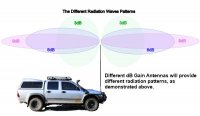Much of the radiation pattern of a given antenna depends on where it is mounted, how it is mounted, type of antenna (1/4 wave, half wave, collinear), adequacy of ground plane, wavelength, etc.
@James Hilger's graphic seems to illustrate a CB "whip" antenna rather than a cell frequency antenna, which would be MUCH shorter and much more subject to interference from the vehicle body and glass.
The higher the frequency (cell frequencies are quite high compared to CB or the common VHF/UHF HAM bands) the more you can expect both reception interference and transmit radiation patterns to be affected by vehicle features such as luggage racks or other antennae - even other vehicles. If your antenna requires a ground plane and you have it clipped to your roof rails, you will KILL your gain, as will mounting it a few inches from a light bar. Likewise, geographic features play their dastardly hand at cell frequencies, so don't be surprised when you lose your signal on the wrong side of a rocky hill. Luckily for chasers, we are usually trying to seek wide open, higher places for better visibility, which is conducive to good cell reception.
At higher frequencies the effects of cable loss and adapters becomes much more pronounced, so try HARD to buy an antenna which has a native connector that fits your equipment - using an adapter can easily cost you 3-6dB of gain. RG-174 cable is convenient because it's skinny and easy to run from an external antenna into your vehicle, but the cost is efficiency. If you must use RG-174, use the shortest run you possibly can and do not under any circumstances allow hard bends or kinks in your cabling.
This might be a good time to mention gain dBi vs dBd. Antenna manufacturers (who often lie about their gain numbers anyway) sometimes use dBi (i=isotropic) as a metric. Dbi is an actual thing so it's not technically misleading, but it's about 2 units larger than dBd, so watch closely when comparison shopping.

